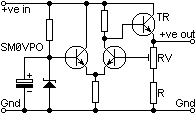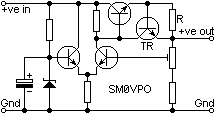

Here are a few different variations of the same theme. All these circuits are normally used for providing power to homemade equipment. Voltage regulator ICs are quite common and normally have a DCin, DCout and Gnd terminal. I will not therefore consider ICs in this article.

A simple Zener diode can be used with a single resistor when low currents are drawn by the load device. This sort of regulator is ideal for regulating the supply voltage for CMOS ICs where only a few micro-amperes or even a few milli-amperes are needed.

R is selected to deliver less than the maximum alowable current for the zener diode, which should also be several times more than the current drawn by the load. Using a 5.6v zener diode will give a temperature co-efficient of about 0V per degree centigrade.

Same circuit again but here a current amplifier has been added. This sort of regulator is more suited to loads drawing a fair few milliamperes such as TTL devices and stages of equipment that need several milliamperes.

A suitable TR would be BC547 or 2N2222 for currents up to 100mA or so. The transistor has a temperature co-efficient of about -2.5mV per degree centigrade, so a 6.8v diode with a +2.5v per degree will give a very temperature stable output. TR may also be a darlington pair (BD547 + TIP41 etc.) to get several amperes output.

Some equipment may require a variable voltage or a voltage that may be set between defined limits. This circuit will set the output voltage by comparing it with a stable reference - the zener diode.

For output currents up to 100mA or so ordinary BC547 transistors can be used, but for several amperes the transistor TR must be replaced with a darlington power type. RV and R forms a voltage divider. If RV is set to maximum then the output voltage will be set to the zener diode (say, 5,6v). With RV set to minimum (down) then the output voltage will be equal to ZD x (R + RV) / R. Let us put in a few values. RV = 10K, R = 6K8 and the Zener is 5.6v. The output voltage can be varied from +5.6v to +13.835v. Since a 5.6v zener diode has a zero temperature co-efficient then the output voltage will also be very temperature stable.
It is interesting to note that this combination of transistors is almost exactly that of an ordinary voltage comparator or operational amplifier IC, such as the 741. If the zener anode and emitter resistor of the first two transistors was reference not to ground, but to minus 5.6v, then the complete regulator would be capable of controlling voltages from zero upwards. Example - R=6K8 and RV=18K, output voltage = 0 to 14.824v - convenient, eh!

All of these circuits could be used inside equipment where there is not normally any possibility of short-circuits. Such regulators used without any form of current limiting could be very dangerous or even have a very short life-span. A bench PSU MUST therefore be equipped with some form of current limiting. Incidentally, TIP41 transistors make loud noises when the plastic top pops off! (they also smell terrible!).

Here, the same variable voltage regulator has been used (after repair). A transistor (TR) and resistor (R) have been added to provide the current limiting. If the output current causes a voltage of more than 0.7v to be developed accross R then TR will conduct and shut down the regulator transistor (shorts base to emitter). The limited output current is therefore equal to 0.7v / Rohms = amperes. 0R68 ohms would limit the output current to one ampere whereas 6R8 would limit the current to 100mA. A resistor of about 1K0 should also be used in the base circuit of TR to prevent damage in larger power supply circuits.

Well, that is about all I have to say about regulators. For more information using a power FET regulator see my simple PSU project. Have fun, de HARRY, Lunda, Sweden.
Return to INFO page